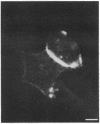Abstract
We have previously identified a 95- to 100-kDa cell surface glycoprotein, which we named BEN (for bursal epithelium and neurons), that is widely expressed during chicken embryonic development. In the central nervous system, it is restricted to subsets of neurons including the motoneurons and the inferior olivary nucleus neurons (which provide the cerebellum with the climbing fibers) where its expression occurs during the phase of axonogenesis and synaptogenesis. In the present work, we show that BEN expression extends to a variety of tissues originating from the three embryonic germ layers. We have found that BEN immunopurified from neural, epithelial, and hemopoietic tissues is differently glycosylated and may or may not carry the HNK-1 epitope. We then cloned a full-length cDNA encoding this protein. Analysis of its sequence reveals that BEN is a member of the immunoglobulin superfamily. Two molecules with an identical cDNA sequence were recently reported: DM-GRASP [Burns, F. R., Von Kannen, S., Guy, L., Raper, J. A., Kamholz, J. & Chang, S. (1991) Neuron 7, 209-220] and SC1 [Tanaka, H., Matsui, T., Agata, A., Tomura, M., Kubota, I., Mcfarland, K. C., Kohr, B., Lee, A., Phillips, H. S. & Shelton, D. L. (1991) Neuron 7, 535-545]. Their pattern of expression and structural properties are consistent with those reported for BEN. Therefore BEN, DM-GRASP, and SC1 are likely to be the same molecule of the immunoglobulin superfamily.
Full text
PDF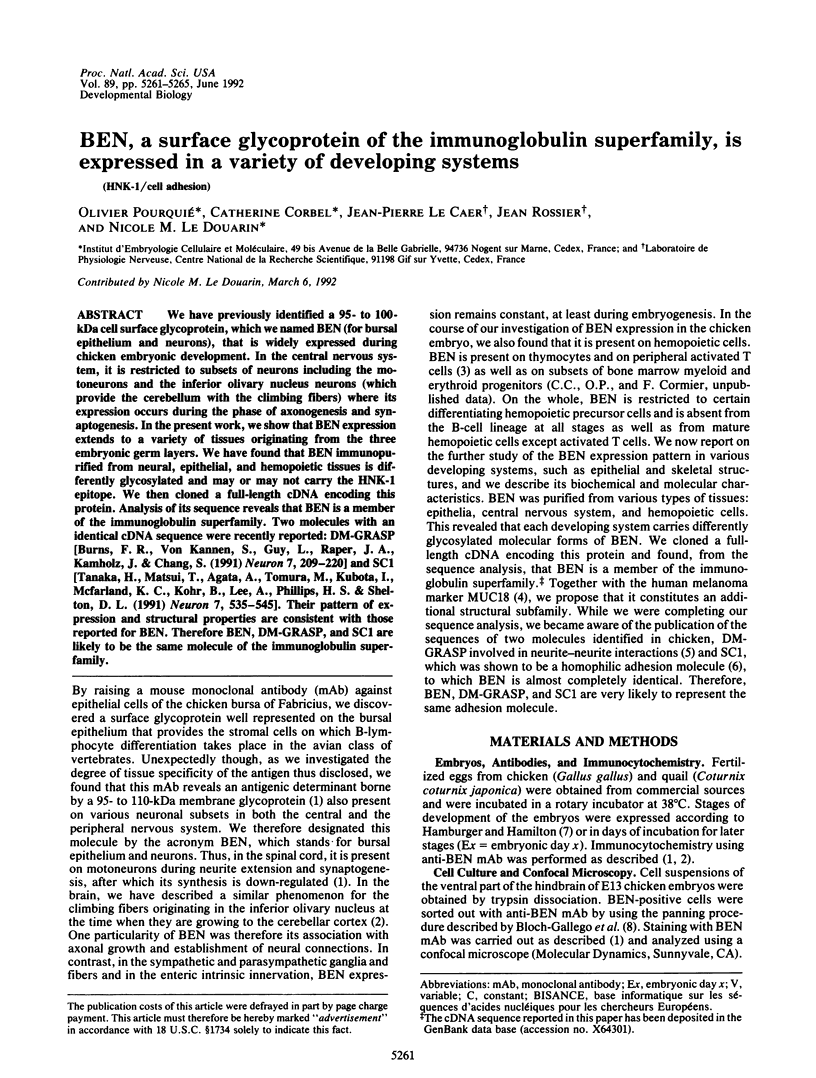
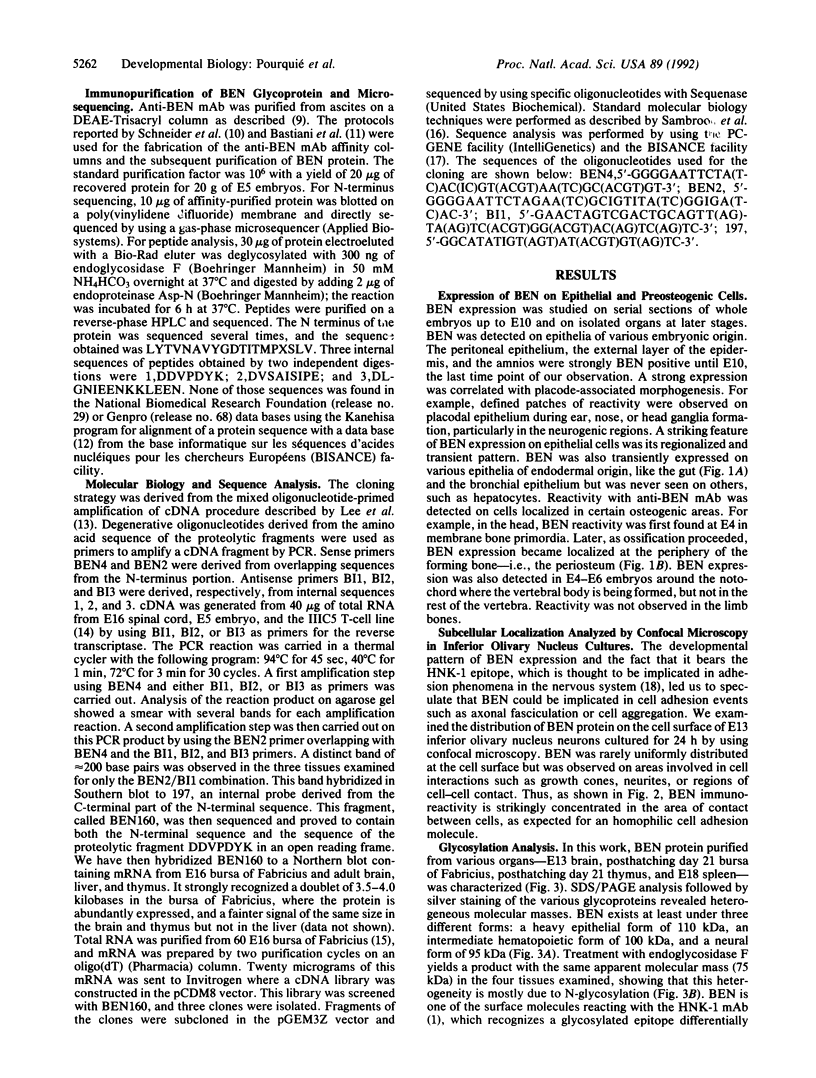

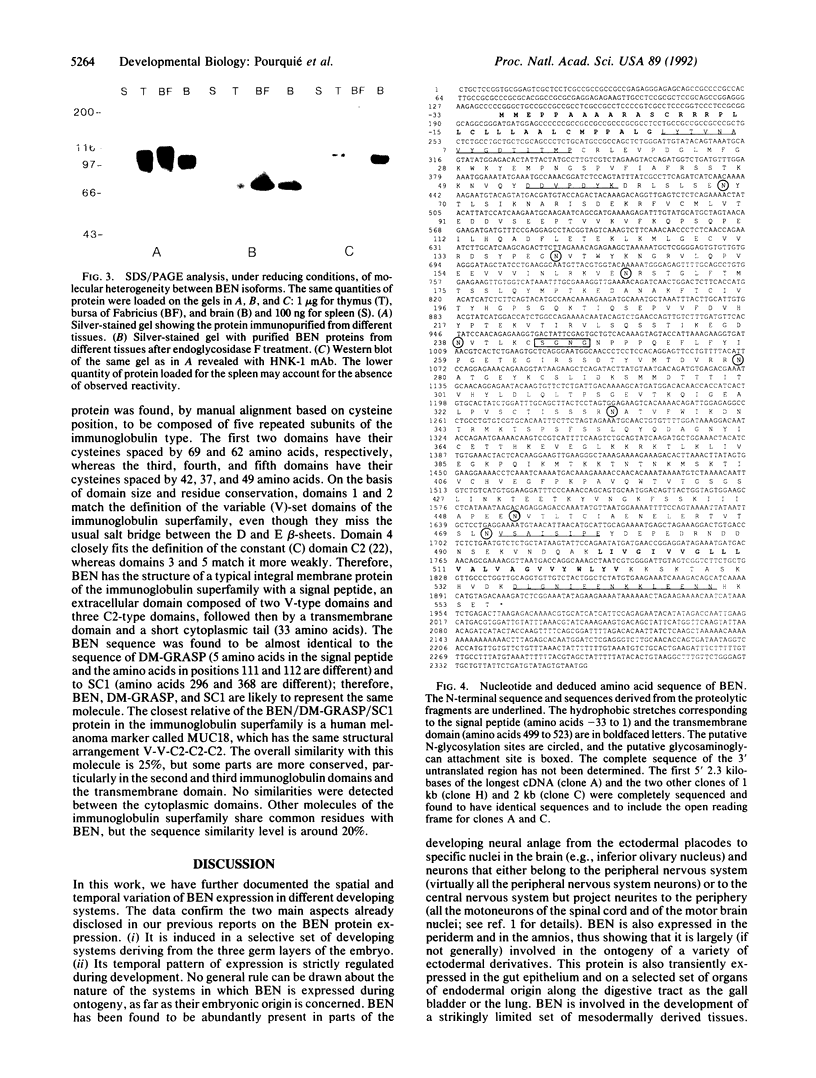
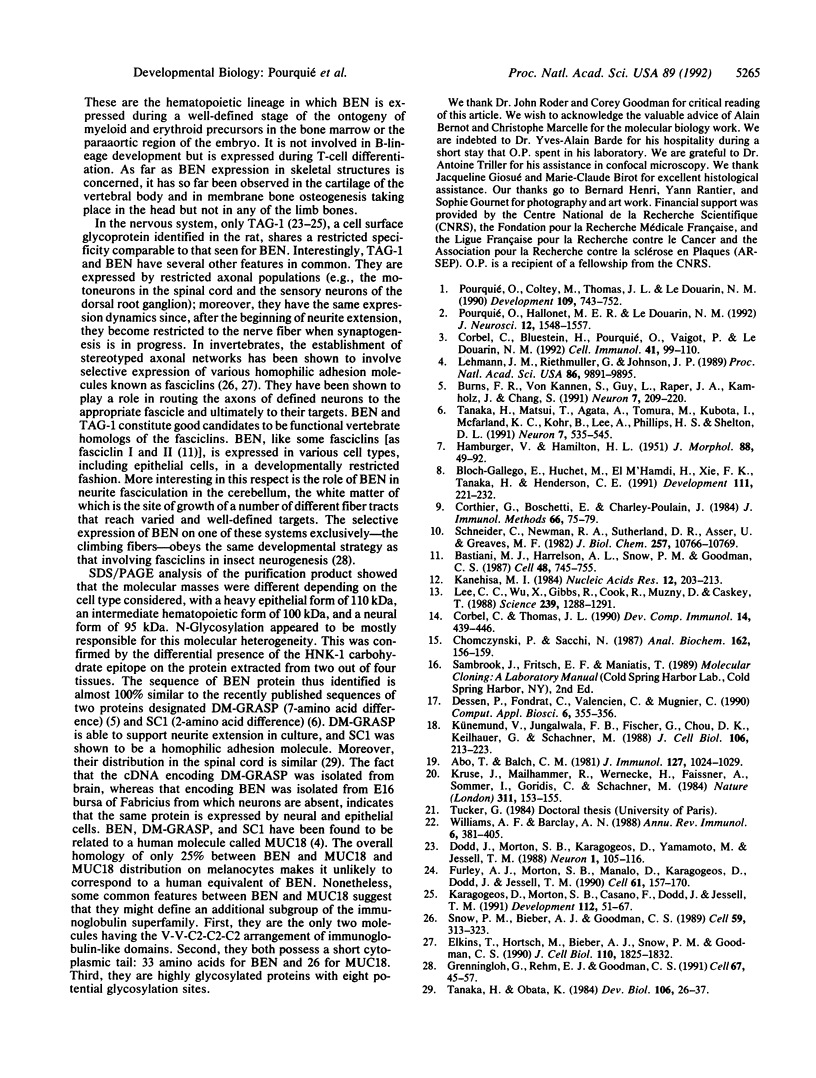
Images in this article
Selected References
These references are in PubMed. This may not be the complete list of references from this article.
- Abo T., Balch C. M. A differentiation antigen of human NK and K cells identified by a monoclonal antibody (HNK-1). J Immunol. 1981 Sep;127(3):1024–1029. [PubMed] [Google Scholar]
- Bastiani M. J., Harrelson A. L., Snow P. M., Goodman C. S. Expression of fasciclin I and II glycoproteins on subsets of axon pathways during neuronal development in the grasshopper. Cell. 1987 Mar 13;48(5):745–755. doi: 10.1016/0092-8674(87)90072-9. [DOI] [PubMed] [Google Scholar]
- Bloch-Gallego E., Huchet M., el M'Hamdi H., Xie F. K., Tanaka H., Henderson C. E. Survival in vitro of motoneurons identified or purified by novel antibody-based methods is selectively enhanced by muscle-derived factors. Development. 1991 Jan;111(1):221–232. doi: 10.1242/dev.111.1.221. [DOI] [PubMed] [Google Scholar]
- Burns F. R., von Kannen S., Guy L., Raper J. A., Kamholz J., Chang S. DM-GRASP, a novel immunoglobulin superfamily axonal surface protein that supports neurite extension. Neuron. 1991 Aug;7(2):209–220. doi: 10.1016/0896-6273(91)90259-3. [DOI] [PubMed] [Google Scholar]
- Chomczynski P., Sacchi N. Single-step method of RNA isolation by acid guanidinium thiocyanate-phenol-chloroform extraction. Anal Biochem. 1987 Apr;162(1):156–159. doi: 10.1006/abio.1987.9999. [DOI] [PubMed] [Google Scholar]
- Corbel C., Bluestein H. G., Pourquie O., Vaigot P., Le Douarin N. M. An antigen expressed by avian neuronal cells is also expressed by activated T lymphocytes. Cell Immunol. 1992 Apr 15;141(1):99–110. doi: 10.1016/0008-8749(92)90130-h. [DOI] [PubMed] [Google Scholar]
- Corbel C., Thomas J. L. Establishment of an IL-2-dependent, antigen nonspecific chicken T-cell line. Dev Comp Immunol. 1990 Fall;14(4):439–446. doi: 10.1016/0145-305x(90)90036-e. [DOI] [PubMed] [Google Scholar]
- Corthier G., Boschetti E., Charley-Poulain J. Improved method for IgG purification from various animal species by ion exchange chromatography. J Immunol Methods. 1984 Jan 20;66(1):75–79. doi: 10.1016/0022-1759(84)90249-7. [DOI] [PubMed] [Google Scholar]
- Dessen P., Fondrat C., Valencien C., Mugnier C. BISANCE: a French service for access to biomolecular sequence databases. Comput Appl Biosci. 1990 Oct;6(4):355–356. doi: 10.1093/bioinformatics/6.4.355. [DOI] [PubMed] [Google Scholar]
- Dodd J., Morton S. B., Karagogeos D., Yamamoto M., Jessell T. M. Spatial regulation of axonal glycoprotein expression on subsets of embryonic spinal neurons. Neuron. 1988 Apr;1(2):105–116. doi: 10.1016/0896-6273(88)90194-8. [DOI] [PubMed] [Google Scholar]
- Elkins T., Hortsch M., Bieber A. J., Snow P. M., Goodman C. S. Drosophila fasciclin I is a novel homophilic adhesion molecule that along with fasciclin III can mediate cell sorting. J Cell Biol. 1990 May;110(5):1825–1832. doi: 10.1083/jcb.110.5.1825. [DOI] [PMC free article] [PubMed] [Google Scholar]
- Furley A. J., Morton S. B., Manalo D., Karagogeos D., Dodd J., Jessell T. M. The axonal glycoprotein TAG-1 is an immunoglobulin superfamily member with neurite outgrowth-promoting activity. Cell. 1990 Apr 6;61(1):157–170. doi: 10.1016/0092-8674(90)90223-2. [DOI] [PubMed] [Google Scholar]
- Grenningloh G., Rehm E. J., Goodman C. S. Genetic analysis of growth cone guidance in Drosophila: fasciclin II functions as a neuronal recognition molecule. Cell. 1991 Oct 4;67(1):45–57. doi: 10.1016/0092-8674(91)90571-f. [DOI] [PubMed] [Google Scholar]
- Kanehisa M. Use of statistical criteria for screening potential homologies in nucleic acid sequences. Nucleic Acids Res. 1984 Jan 11;12(1 Pt 1):203–213. doi: 10.1093/nar/12.1part1.203. [DOI] [PMC free article] [PubMed] [Google Scholar]
- Karagogeos D., Morton S. B., Casano F., Dodd J., Jessell T. M. Developmental expression of the axonal glycoprotein TAG-1: differential regulation by central and peripheral neurons in vitro. Development. 1991 May;112(1):51–67. doi: 10.1242/dev.112.1.51. [DOI] [PubMed] [Google Scholar]
- Kruse J., Mailhammer R., Wernecke H., Faissner A., Sommer I., Goridis C., Schachner M. Neural cell adhesion molecules and myelin-associated glycoprotein share a common carbohydrate moiety recognized by monoclonal antibodies L2 and HNK-1. Nature. 1984 Sep 13;311(5982):153–155. doi: 10.1038/311153a0. [DOI] [PubMed] [Google Scholar]
- Künemund V., Jungalwala F. B., Fischer G., Chou D. K., Keilhauer G., Schachner M. The L2/HNK-1 carbohydrate of neural cell adhesion molecules is involved in cell interactions. J Cell Biol. 1988 Jan;106(1):213–223. doi: 10.1083/jcb.106.1.213. [DOI] [PMC free article] [PubMed] [Google Scholar]
- Lee C. C., Wu X. W., Gibbs R. A., Cook R. G., Muzny D. M., Caskey C. T. Generation of cDNA probes directed by amino acid sequence: cloning of urate oxidase. Science. 1988 Mar 11;239(4845):1288–1291. doi: 10.1126/science.3344434. [DOI] [PubMed] [Google Scholar]
- Lehmann J. M., Riethmüller G., Johnson J. P. MUC18, a marker of tumor progression in human melanoma, shows sequence similarity to the neural cell adhesion molecules of the immunoglobulin superfamily. Proc Natl Acad Sci U S A. 1989 Dec;86(24):9891–9895. doi: 10.1073/pnas.86.24.9891. [DOI] [PMC free article] [PubMed] [Google Scholar]
- Pourquié O., Coltey M., Thomas J. L., Le Douarin N. M. A widely distributed antigen developmentally regulated in the nervous system. Development. 1990 Aug;109(4):743–752. doi: 10.1242/dev.109.4.743. [DOI] [PubMed] [Google Scholar]
- Pourquié O., Hallonet M. E., Le Douarin N. M. Association of BEN glycoprotein expression with climbing fiber axonogenesis in the avian cerebellum. J Neurosci. 1992 Apr;12(4):1548–1557. doi: 10.1523/JNEUROSCI.12-04-01548.1992. [DOI] [PMC free article] [PubMed] [Google Scholar]
- Schneider C., Newman R. A., Sutherland D. R., Asser U., Greaves M. F. A one-step purification of membrane proteins using a high efficiency immunomatrix. J Biol Chem. 1982 Sep 25;257(18):10766–10769. [PubMed] [Google Scholar]
- Snow P. M., Bieber A. J., Goodman C. S. Fasciclin III: a novel homophilic adhesion molecule in Drosophila. Cell. 1989 Oct 20;59(2):313–323. doi: 10.1016/0092-8674(89)90293-6. [DOI] [PubMed] [Google Scholar]
- Tanaka H., Matsui T., Agata A., Tomura M., Kubota I., McFarland K. C., Kohr B., Lee A., Phillips H. S., Shelton D. L. Molecular cloning and expression of a novel adhesion molecule, SC1. Neuron. 1991 Oct;7(4):535–545. doi: 10.1016/0896-6273(91)90366-8. [DOI] [PubMed] [Google Scholar]
- Tanaka H., Obata K. Developmental changes in unique cell surface antigens of chick embryo spinal motoneurons and ganglion cells. Dev Biol. 1984 Nov;106(1):26–37. doi: 10.1016/0012-1606(84)90057-5. [DOI] [PubMed] [Google Scholar]
- Williams A. F., Barclay A. N. The immunoglobulin superfamily--domains for cell surface recognition. Annu Rev Immunol. 1988;6:381–405. doi: 10.1146/annurev.iy.06.040188.002121. [DOI] [PubMed] [Google Scholar]



